Last updated: May 7, 2024
Article
The Transcontinental Telegraph
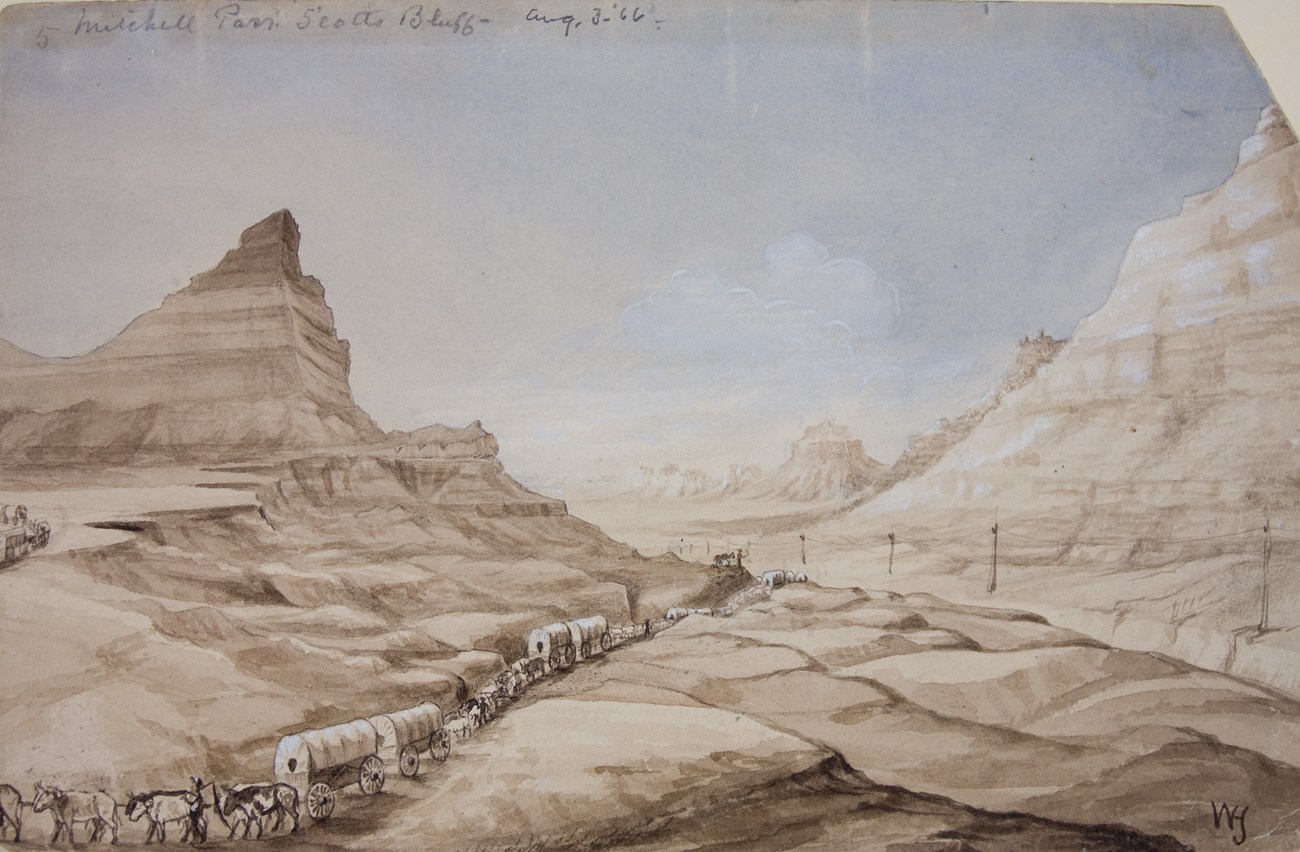
William Henry Jackson from the Scotts Bluff National Monument Collection (SCBL-27).
The first transcontinental telegraph, which followed the path of the Oregon-California Trail through Mitchell Pass in what is now Scotts Bluff National Monument, enabled nearly instantaneous electronic communication across North America for the first time. Telegraphy was the first form of electronic communication and contributed to the progression of telecommunication systems which have become a significant part of life in the 21st century.
Telegraphs Before Electricity
The word telegraph is derived from the Greek words tele, meaning “distant,” and graphein, meaning “to write.” Rather than using electricity, the first practical telegraph systems used semaphores such as flags, moveable arms, or other objects which could be moved to various positions representing the letters of the alphabet. Starting in the late 18th century, visual telegraphs were mounted on hills or towers to communicate messages over distances of several miles, between stations which were in sight of each other. Telegraph towers could be built in a chain with each tower being within visual range of the neighboring towers to relay messages over longer distances than a direct line of sight between the initial transmitting station and the ultimate receiving station.
The Invention of the Battery and the Discovery of Electromagnetism
Human knowledge of electricity rapidly expanded in the late 18th and early 19th centuries. Experimentation conducted by two Italian physicists, Luigi Galvani, and Alessandro Volta, led to Volta’s invention of the voltaic pile in 1800, which was the first electric battery. The voltaic pile used a stack of discs made from two alternating metals separated by paper or cloth soaked with a salt solution. The voltaic pile used a chemical reaction to supply a steady electric current, instead of a charge of static electricity provided by the earlier Leyden jar, which was an early form of capacitor. Benjamin Franklin is credited for the first use of the term “battery”, when he connected several Leyden jars to increase their power in the 1750s. The connected jars reminded Franklin of a military battery of cannons arranged together.
In 1820, a Danish scientist named Hans Christian Ørsted discovered a relationship between electrical energy and magnetism. Ørsted was experimenting with a voltaic pile connected to a circuit and observed that the magnetized needle of a compass next to the wires moved every time the circuit was completed. In 1825, English scientist William Sturgeon discovered that the electromagnetic effect could be enhanced by wrapping wire around an iron core. Further improvements to electromagnets eventually contributed to the creation of the first practical electromagnetic telegraphs.
The Cooke-Wheatstone Telegraph
No single inventor can be credited with the invention of the first electronic telegraph. The contributions of the physicists mentioned in earlier paragraphs, along with further experimentation led to the evolution of Samuel Morse’s telegraph. Experiments with static electricity in the later decades of the 18th century led several scientists to propose methods of using static electricity to communicate over long distances, but these systems were cumbersome and impractical. Following Ørsted’s discovery of electromagnetism, several groups of scientists attempted to create practical electromagnetic telegraph systems including Sir William Cooke and Sir Charles Wheatstone. Cooke and Wheatstone invented a telegraph using needles to indicate letters of the alphabet which they patented in London in 1837. The first permanent telegraph system was completed in 1839 along the Great Western Railway, using a Cooke-Wheatstone telegraph to connect London’s Paddington Station to the city of West Drayton Station, a distance of 13 miles. Although the Cooke-Wheatstone telegraph was the first electronic telegraph design to enter commercial service, Samuel Morse’s simpler telegraph key and sounder became the most successful design.
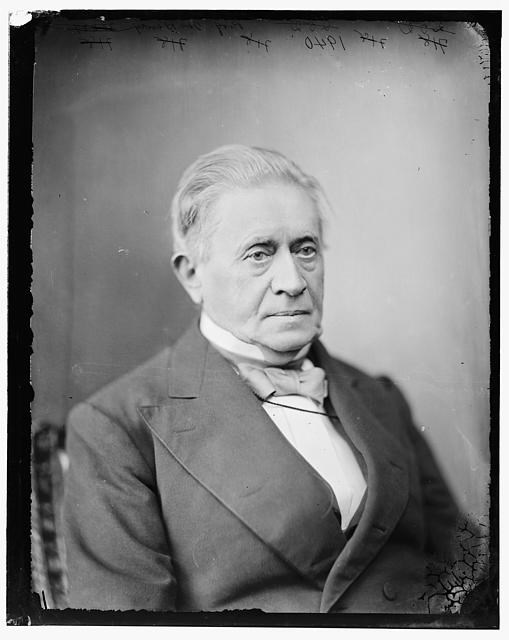
U.S. Library of Congress. Digital ID: (digital file from original neg.) cwpbh 05156 https://hdl.loc.gov/loc.pnp/cwpbh.05156
Joseph Henry’s Research
One of the challenges of sending electrical impulses through long distances of wire is known as electrical resistance, which is a force that counteracts the flow of current through a substance such as metallic wire. Joseph Henry, an American physicist, found that he could create electromagnets capable of working further from the battery by wrapping several shorter coils of insulated wire around the iron core and wiring the coils in series, which increased the voltage. Following his research on reducing problems with electrical resistance, Henry published an article in Benjamin Silliman's American Journal of Science in January of 1831. Henry intended to demonstrate the potential use of an electromagnetic telegraph and constructed a prototype telegraph with a battery and higher-voltage electromagnet connected by a mile of copper wire which he demonstrated as an instructor at the Albany Academy in New York. The electromagnet attracted and repelled a permanent magnet, which would tap a bell. Henry set up his prototype in a lecture hall at the Albany Academy and demonstrated his prototype to students attending his classes. Princeton University hired Henry as a professor in 1832 and he continued his telegraph experiments by stringing wires between two campus buildings. In 1837, Henry visited London and provided information to Charles Wheatstone on methods of sending telegraph signals further.
Samuel Morse
Samuel Morse was born in 1791 in Massachusetts. While Morse was a student at Yale he was fascinated by lectures on electricity. Morse studied painting and he worked as a portrait painter and taught art at New York University. Morse was also politically active, supporting nativist (anti-immigration) positions. New York City was the largest port of entry for European immigrants entering the United States in the 19th century and became a center of nativist activity among people born in the United States. Nativists opposed the arrival of impoverished Irish and German immigrants and feared that Catholic immigrants would impose Vatican control over the United States. Morse wrote a nativist tract titled “Foreign Conspiracy against the Liberties of the United States” in 1835 and helped establish the first anti-immigration political party called the Native American Democratic Association. The use of the term “Native American” by nativists refers to white Americans descended from earlier generations of American colonists and does not refer to the indigenous people of North America.
In 1825, Morse was commissioned to paint a portrait of the Marquis de Lafayette. While painting the portrait in Washington, D.C., Morse received a letter from his father informing him that his wife Lucretia had died while recovering from childbirth at their home in New Haven, Connecticut. By the time Morse returned to New Haven, Lucretia had already been buried. This tragedy may have inspired Morse to look for faster ways to send messages. In 1832 Morse became interested in designing an electromagnetic telegraph when he had a conversation about electromagnetism with a fellow passenger while crossing the Atlantic after studying art in Europe. For several years, Morse worked to develop his telegraph idea while continuing to paint and teach art at NYU. During the winter of 1836-1837, Morse requested help from a chemistry instructor at NYU named Leonard Gale, who helped Morse make a high voltage electromagnet based on Joseph Henry’s design. Gale also encouraged Morse to read Henry’s 1831 paper, and using a battery wired in series and an electromagnet with hundreds of wire turns, Morse and Gale were able to send signals through 10 miles of wire.
Morse communicated with Henry during the late 1830s and early 1840s, and while Henry willingly provided advice to Morse, he clearly believed that Morse’s telegraph was simply an application of scientific principles discovered by himself and other physicists. Henry’s relationship with Morse deteriorated in the fall of 1845 when Morse’s assistant Alfred Vail published a book on the history of the electromagnetic telegraph. Henry did not believe Vail adequately credited him for the electromagnetic discoveries that made the telegraph possible. Although Henry voiced his complaints to Morse, Morse claimed that he was not involved with Vail’s book. Henry was appointed as the first Secretary of the Smithsonian Institution in 1846 and served in this position until his death in 1878.
Morse Code
Samuel Morse and his assistant Alfred Vail contributed to the development of a system of dots and dashes known as Morse Code in the 1830s. The original system of Morse Code was inadequate for communicating in languages using diacritic marks, and a new series of dots and dashes known as International Morse code was introduced in 1851 for communications within Europe. The original code became known as American Morse code, and it continued to be used in the United States into the 20th century because American telegraphers resisted switching to international Morse code. When the first transatlantic telegraph cables were installed, American telegraphers sending messages across the Atlantic needed to be proficient in both American and International Morse code to transfer messages between the American telegraph system and the transatlantic lines. Most people with a casual knowledge of Morse Code are more familiar with International Morse code. SOS, perhaps the most famous Morse Code message, corresponds to the familiar
▄ ▄ ▄ ▄▄▄ ▄▄▄ ▄▄▄ ▄ ▄ ▄ combination in International Morse Code, and was first used as a distress signal in maritime radio communication in the early 1900s. SOS in American Morse Code would correspond to a different combination of dots and dashes, and was not used as a distress signal in 19th Century North American telegraphy. Rather than consisting of a simple array of dot and dash combinations like International Morse Code, American Morse Code also included dashes of three varying lengths.
Morse’s First Commercial Long-Distance Telegraph
In 1837, Samuel Morse submitted a proposal to the Secretary of the Treasury for funding to construct a commercial electronic telegraph system. Morse demonstrated his telegraph devices to Senators, Representatives, and President Martin van Buren. In 1843, the Senate and House of Representatives approved funding for Morse to construct a test line between Washington, D.C. and Baltimore, Maryland. The Baltimore and Ohio Railroad allowed Morse to build a telegraph line along the railroad’s right-of-way, and Morse hired the mechanic, inventor, and businessman Ezra Cornell to install the cables. Cornell’s assistants started installing insulated cables inside a lead pipe buried in an underground trench. After the underground cables failed to operate due to poor insulation and condensation in the pipes after several miles were buried, Cornell switched to stringing the cables from poles and trees, and invented glass insulators to prevent current from shorting out where wires connected to the poles. Cornell continued to work on telegraph projects and was a major stockholder in several telegraph companies including Western Union. After becoming wealthy from the growing telegraph industry, Cornell helped establish Cornell University in Ithaca, New York in 1865.
On May 24, 1844, Samuel Morse sent the first message on the 40-mile telegraph line from the Supreme Court Chamber, which was in the U.S. Capitol Building at the time, to Alfred Vail at Baltimore’s Mt. Claire Station. Vail then sent the message back to Morse. The message, “What hath God wrought?”, was taken from Numbers 23:23 in the Bible, and suggested by Annie Ellsworth, who was the young daughter of one of Morse’s friends. Guests of Morse who were present at the Capitol included Whig presidential candidate Henry Clay, Former First Lady Dolley Madison, and Alice Key, who was the daughter of Francis Scott Key, the composer of the Star-Spangled Banner. The Baltimore-Washington D.C. telegraph line was a success, and by the end of the 1840s telegraph lines connected towns throughout the eastern states.
Hiram Sibley and the Establishment of Western Union
In 1849, Hiram Sibley, a machine shop operator, banker, real estate agent, and sheriff of Monroe County, New York attempted to establish a printing telegraph company with his business partner Judge Samuel Selden of Rochester, New York. Sibley and Selden discovered that there were too many small telegraph companies to compete with. Sibley and Selden decided to acquire all the telegraph lines west of Buffalo, New York, and consolidate them into a single company. Sibley’s company acquired 11 telegraph companies operating north of the Ohio River, and in 1856 the company was renamed the Western Union Telegraph Company, indicating that the western telegraph lines had been unified into a single company. In the early 1850s, there were over 50 separate telegraph companies operating in the United States. Through the consolidation of companies, only six major U.S. telegraph companies were in operation by 1861.
The Telegraph comes to California
After telegraph communication expanded across the eastern United States, entrepreneurs began planning telegraph lines to connect towns in the newly admitted state of California. San Francisco’s Telegraph Hill received its name in 1849 when a semaphore telegraph was constructed on the hill to notify the city’s merchants when ships were sighted entering the Golden Gate. In 1853, a telegraph line was installed from Point Lobos, near the Golden Gate, to downtown San Francisco, rendering the semaphore station obsolete. The California State Telegraph Company also began construction of a telegraph line in 1853 to connect San Francisco with San Jose, Stockton, Sacramento, and Marysville. Workers began stringing lines south from San Francisco towards San Jose on September 13, 1853 and reached Marysville on October 25. A ten-word message from San Francisco to San Jose cost 75 cents, and a message from San Francisco to a more distant town cost two dollars. Ideas to build a transcontinental telegraph line had been proposed throughout the 1850s. The California Legislature offered $6,000 a year as an incentive for the first company to complete a transcontinental telegraph line, and two competing companies tried to start the first lines across the continent. The Placerville Humboldt Company built a line to Carson City in the spring of 1859 and planned to continue east through Nevada along the path of the Central Overland Trail. The Pacific Atlantic Company completed a telegraph line running from San Francisco south to Los Angeles in 1860, hoping to continue the line across the southwestern U.S. via the Butterfield Overland Mail route. Both companies would eventually merge with the California State Telegraph Company, and with additional federal funding, California would soon become connected electronically with the eastern states.
Funding the First Transcontinental Telegraph
The demand for a commercial telegraph line connecting the Atlantic and Pacific coasts continued to grow substantially as the population of California increased. The U.S. government also saw the value of a transcontinental telegraph to increase the speed of military communication between forts. Hiram Sibley of Western Union proposed the construction of a transcontinental telegraph to the Western Union board, but the other members were hesitant to participate in the project. The enormous cost of building and maintaining a telegraph line crossing the western plains, mountains, and deserts discouraged investors from funding a transcontinental telegraph, and it became evident that government funding was necessary to make the transcontinental telegraph a reality.
On June 16, 1860, President James Buchanan signed “An Act to Facilitate Communication between the Atlantic and Pacific States by Electric Telegraph”, also known as the Pacific Telegraph Act, after it was approved by Congress. The Pacific Telegraph Act authorized the Secretary of the Treasury to seek proposals for the construction of an electromagnetic telegraph to connect the eastern cities to San Francisco. The act specified that the United States Government would provide up to $40,000 a year for up to ten years to fund the construction and maintenance of the telegraph and would authorize the telegraph company to occupy public land along the route. The Pacific Telegraph Act also required the transcontinental telegraph to include stations for repairs along the route, no more than 15 miles apart on average. Congress was supportive of the Pacific Telegraph act because the act also specified that while the telegraph could be used to send messages between private citizens, messages sent by the government had priority, and the government had the privilege of connecting military posts by telegraph. In addition to government communication, the act authorized the Smithsonian Institution, the Coast Survey, and the National Observatory to use the telegraph free of cost for scientific purposes.

Illustration by the Western Museum Lab 1936.
Building the First Transcontinental Telegraph
Several companies submitted bids to construct the transcontinental telegraph, but every company withdrew their bid before the deadline except for the Western Union Company, which was awarded the contract by Secretary of the Treasury Salmon P. Chase. California’s Overland Telegraph Company and Nebraska’s Pacific Telegraph Company were organized to construct the telegraph on behalf of Western Union. The Pacific Telegraph Company agreed to construct the telegraph line from Omaha west to Salt Lake City, and the Overland Telegraph Company agreed to complete the line from Carson City, which was the easternmost point on California’s telegraph system, east to Salt Lake City. Edward Creighton surveyed the Pacific Telegraph Company’s route and oversaw the construction crew building west from Omaha. Creighton worked in his younger years as a wagon freighter and proceeded with a career building telegraph lines throughout the Midwest. Creighton settled in Omaha in 1857 and was elected as the president of the First National Bank of Omaha in 1863. Creighton University was founded in his memory following his death in 1874.
On July 4, 1861, work began on the transcontinental telegraph, with the two crews placing wagers and competing to reach Salt Lake City first. The first workers surveyed and marked the telegraph route, and were followed by workers digging holes, installing poles, and stringing wires. Three to eight miles of telegraph line were installed every day, and a mobile telegraph station was used by crews to send updates on the telegraph’s progress to the city they started from. An immense number of resources were needed to construct the transcontinental telegraph. Hundreds of oxen were obtained to haul supplies by wagon. Supplies for the western section of the transcontinental telegraph such as wires and insulators were manufactured in the eastern U.S., then shipped to California via Cape Horn. Obtaining poles was another major challenge across the treeless expanses of the Great Plains and Great Basin, and many workers and wagons were assigned to this task. Edward Creighton was sent to Salt Lake City, and made arrangements with Brigham Young, President of the Church of Jesus Christ of Latter-Day Saints, for Mormon workers to supply the poles for a large stretch of the telegraph route.
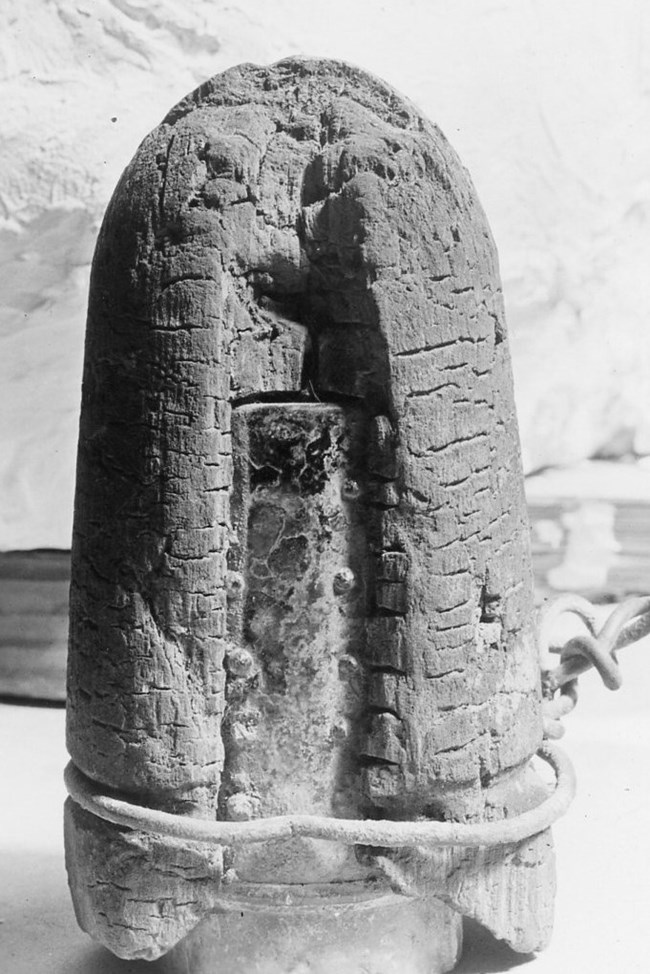
NPS photo
The Completion of the First Transcontinental Telegraph
On October 24, 1861, the transcontinental telegraph was completed when the Overland Telegraph Company reached Salt Lake City, several days after the Pacific Telegraph Company completed their eastern section (the exact completion date of the Pacific Telegraph Company varies among the various historical accounts). On the evening of October 24, Brigham Young was given the privilege of writing the first telegram to be sent from Salt Lake City to San Francisco, which he addressed to H. W. Carpentier, President of the Overland Telegraph Company. The first message sent all the way across the continent was sent from Sacramento by Stephen J. Field, Chief Justice of the California Supreme Court, to President Abraham Lincoln in Washington, D.C. Field’s telegram congratulated Lincoln on the completion of the telegraph and pledged that California would stand by the U.S. government during its time of trial. Field’s telegram was sent at 7:40 PM on October 24 and was received by President Lincoln at 11:30 the following morning, enabling transcontinental communication in a fraction of the time required by the Pony Express and stagecoach mail services. Additional messages sent from the eastern US to California included updates on Civil War battles, including news of the death of Oregon’s US Senator Colonel Edward Dickinson Baker at the Battle of Ball’s Bluff in Virginia on October 21.
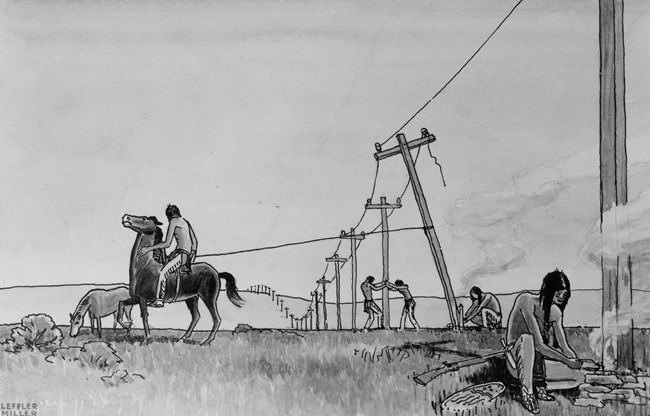
Leffler Miller
The Transcontinental Telegraph’s Role in Native American Relations
Tensions between Native Americans and European-Americans travelling through and settling on traditionally indigenous lands were a major part of the history of the Western US in the 19th Century. This ongoing conflict also influenced the construction, operation, and roles which the first transcontinental telegraph served. Several Native Americans were employed to drive and herd livestock during the construction of the telegraph and were paid in provisions and clothing. According to James Gamble’s account, the American Indian workers were treated well, to build favorable relations with the region’s tribes. Telegraph representatives including James Street met with Native American Chiefs including Sho-kup, the Head Chief of the Shoshone.
Not all accounts of meetings between telegraph executives and American Indian representatives were as friendly as Gamble’s description of the meeting with Sho-kup. According to Captain Eugene F. Ware in his account titled The Indian War of 1864, "It may be thought strange that the Indians did not secretly destroy the telegraph line. There were a number of strange stories connected with it, and with Indian experience. In order to give the Indians a profound respect for the wire, chiefs had formerly been called in and had been told to make up a story and then separate. When afterwards the story was told to one operator where one chief was present, it was told at another station to the other chief in such a way as to produce the most stupendous dread. No effort was made to explain it to the Indians upon any scientific principle, but it was given the appearance of a black and diabolical art. The Indians were given some electric shocks; and every conceivable plan, to make them afraid of the wire, was indulged in by the officers and employés of the company, it being much to their financial advantage to make the Indian dread the wire.” With its bare poles and wires strung across the landscape, the telegraph was unlike any technology people had seen before, whether they were European-American or Native American. Both Gamble and Wells describe other fears which prevented Native Americans from attacking the telegraph in the early years, such as experiences with accidental electrical shock, and the tendency of the iron telegraph wire to attract lightning.
The Battle of Mud Springs in February 1865 illustrated the role the telegraph played in increasing the speed of military communication along the Platte. The attack on Mud Springs followed the November 29, 1864 Sand Creek Massacre, in which soldiers commanded by John Chivington killed about 230 Cheyenne and Arapaho who were camped in southeastern Colorado. Following the Sand Creek Massacre, a large group of Cheyenne, Sioux, and Arapaho headed north toward the relatively isolated Sand Hills and Black Hills. To avenge their relatives killed in the Sand Creek Massacre and to gather supplies for their journey, the group of warriors attacked settlements along the South Platte River. After raiding Julesburg, the warriors retreated north, toward the Mud Springs telegraph station, which was located east of Scotts Bluff, about 12 miles southeast of present-day Bridgeport, Nebraska. The telegrapher at Mud Springs called for help from Fort Mitchell and Fort Laramie, and Colonel William O. Collins sent troops from both forts to successfully defend Mud Springs. An account of the Battle of Mud Springs and related events is included in Captain Ware’s book The Indian War of 1864.
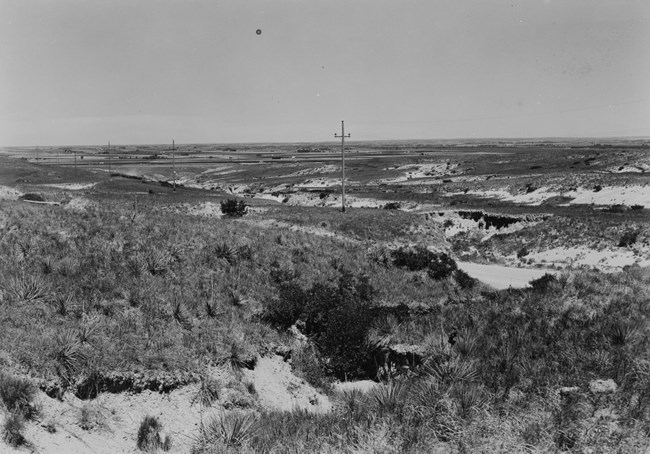
NPS/George Grant
After the Transcontinental Telegraph
Although the transcontinental telegraph revolutionized communication between the eastern and western states, it soon became obsolete as the progression of technology continued. Less than a decade after the completion of the first transcontinental telegraph in 1861, the golden spike was driven at Promontory Summit, Utah, on May 10, 1869, ceremonially completing the first transcontinental railroad. Much like the transcontinental telegraph, the transcontinental railroad was built by two crews from the east and west, who met near the Great Salt Lake. A more advanced multi-wire telegraph system was built along the transcontinental railroad, and the first transcontinental telegraph was no longer the primary telegraph line across the west. As the first form of nearly instantaneous electronic communication, telegraphy left a legacy which continues to the modern era. Alexander Graham Bell patented his telephone in 1876, and much like the telegraph, it operated by sending electrical impulses through wires. In the 1890s, Guglielmo Marconi developed the radio. Before radio technology was capable of transmitting voice and music broadcasts, it transmitted Morse code. Early radios were referred to as “wireless telegraphs” because they could send and receive Morse code without the wires of previous systems. The evolution of television, cellular phones, and the internet continued, becoming vital parts of life in the 21st Century.
Despite the introduction of new communication forms, the telegraph system survived through the first half of the 20th Century, and technologies such as teletype were used in addition to Morse code. The popularity of telegrams peaked in the 1920s and 1930s, because telegrams were more affordable than long-distance telephone calls. During World War II, the Korean War, and the Vietnam War, the military used Western Union telegrams to notify families if a servicemember were killed, wounded, taken prisoner, or missing in action. Western Union’s first geostationary communications satellite, Westar 1, was launched in 1974. Westar 1 was used by Western Union for internal telegram communications and was also used for satellite television broadcasting including HBO’s debut in 1975. After a bankruptcy in the 1990s, Western Union’s telegram service managed to survive until 2006, and most telegrams in the last years were used by businesses for official notifications. Western Union continues to survive today by offering money transferring services, and is now headquartered in Denver, Colorado.
